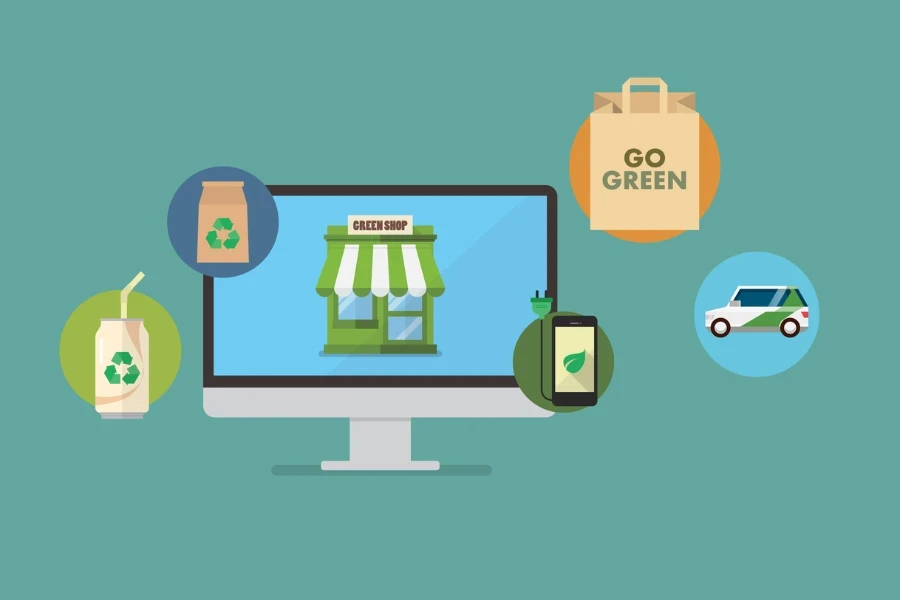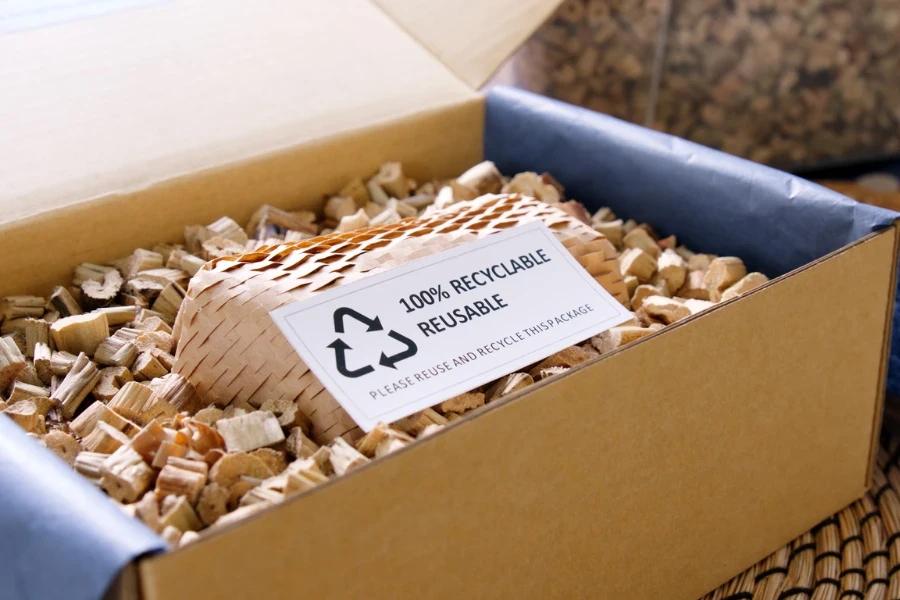E-commerce continues to establish itself as a prominent channel for retail. According to projections from Statista, online retail revenue will surpass USD 8 trillion by 2026, reflecting sustained growth in demand for online shopping over recent years. However, the expansion of e-commerce has contributed to increased waste levels as packaging materials accumulate.
Many consumers have also become aware of the mounting environmental effects of delivery packaging through reported issues such as the Great Pacific Garbage Patch. While interested in the conveniences of online purchases, some customers have started to consider the implications of the volumes of packaging required to support e-commerce and are now inclined to support brands that demonstrate a strong commitment to sustainability.
You may be wondering, then, what sustainable e-commerce is, and how it can be leveraged to boost your business’s success? With the growing need to address these concerns, this article will cover everything businesses should know about sustainable business practices, as well as offering seven sustainable e-commerce strategies.
Table of Contents
What is sustainable e-commerce?
Benefits of sustainable practices for your business
Top 7 sustainable e-commerce strategies
Measuring and tracking
Conclusion
What is sustainable e-commerce?

Sustainable e-commerce refers to operating an online business in an environmentally conscious and socially responsible way. It is mostly characterized by waste reduction, using recycled and recyclable packaging, and selling eco-friendly products.
Sustainable e-commerce is gaining traction globally, as witnessed by 2022’s accumulative sales closing at USD 13.06 billion. Experts expect this figure to skyrocket at a compound annual growth rate (CAGR) rate of 15.38%, reaching a new high of USD 40.75 billion by 2030.
The report by Market Digits reveals that a shift in consumer preferences toward businesses that prioritize sustainability has played a huge role in influencing strategies and practices of e-commerce enterprises worldwide. Looking forward, retailers may need to prioritize sustainable solutions to satisfy the changing choices of conscientious consumers.
Benefits of sustainable practices for your business
1. Cost savings
One of the advantages of sustainable e-commerce is that it saves money for your business. Using less energy, water, and materials reduces utility and supply costs. Moreover, employing habits like turning off lights and electronics when not in use, reducing waste, and recycling supplies assists in cutting your costs significantly in the long run.
2. Tax incentives

Another way your business benefits from sustainable practices is through government incentives. Many governments offer tax breaks, rebates, or credits for businesses implementing eco-friendly changes like renewable energy, waste reduction programs, and more.
For instance, the US government provides commercial clean vehicle tax credits of up to USD 7500 per vehicle to companies that buy an electric vehicle. Companies also receive tax deductions of USD 1.88 per square foot for making energy-efficient adjustments like lighting and HVAC to their buildings. These incentives can add up to major savings for your company.
3. Competitive advantage
Sustainable businesses are hugely attractive to today’s consumers. In fact, 81% of consumers preferred to buy from sustainable sellers, as reported by Recycling Lives, a recycling company in the United Kingdom. Highlighting your green practices have the potential to set you apart from your competition, build brand loyalty, and attract new environmentally conscious clients.
4. Increased productivity
When employees work in an office with natural light, greenery, and good air quality, productivity improves. An Exeter University study found that employees were 15% more productive when working in a “green” office than in ordinary office spaces. Sustainable practices like optimizing HVAC systems, using low-VOC paints and furniture, and bringing in plants have been shown to boost focus, creativity, and work quality.
5. Increases business values
Incorporating environmentally sustainable practices in your business positively impacts your business’s values. Your business values rise as you attract more conscious buyers and increase the loyalty of your existing customers.
One way to make the most out of your new customer base is by raising your prices, as 70% of people are willing to pay more to support an eco-friendly company. In addition, the consumers in the study revealed that they would pay 5% more for a green product that matched the performance standards of a non-green alternative.
6. Future proofing
Regulations on pollution, waste, and emissions are increasing around the world. Countries like Kenya, France, Rwanda, Morocco, and 127 other UN countries have banned single-use plastics, with violators receiving heavy fines.
By adopting sustainable practices, you ensure your business is prepared for additional regulations that may come into effect down the road. You are also less likely to incur the fees for non-compliance in the future.
Top 7 sustainable e-commerce strategies
1. Offer eco-friendly shipping
Providing an eco-friendly delivery service to your customers is a good way to become a sustainable company. Employing strategies like shipping packaging that can be recycled instead of being thrown away or special printers that don’t require ink can help reduce the waste that ends up in landfills. Companies like FedEx, UPS, and USPS have adopted programs where you can get invoices and stuff online instead of mail, saving paper.
Amazon has also gotten in on the action to offer sustainable shipping. In 2021, they ordered over 700 natural gas trucks, better than diesel-powered trucks with lower emissions. They also ordered 100,000 electric vans from Rivian for short local deliveries. Efforts like these can help reduce how much carbon your company puts out.
2. Provide eco-friendly packaging

In addition to eco-friendly shipping, you can minimize waste by using eco-friendly packaging for your products. Sustainable packaging products comprise materials like paper and cardboard which ditch the use of non-biodegradable materials like plastic and foam.
Providing biodegradable packaging helps to contribute to your sustainable supply chain and increases the popularity of your products among customers who prefer eco-friendly online stores. This is why Amazon UK stopped packing orders in single-use plastic bags.
Using the appropriate packaging size also helps with your sustainability efforts. Large boxes occupy extra space, and using a fitting packaging box reduces the wastage of material that can be used to package other deliveries. For instance, Puma’s Clever Little Bag has a minimal packaging design that is better for the environment compared to its previous huge-size packing bags and boxes.
3. Source sustainable and ethical products
Another sustainable e-commerce strategy by selling products made from recycled, upcycled, or organic materials. You can source raw materials from minority-owned, women-owned, and local businesses.
This ensures you form long-term partnerships with ethical suppliers who provide sustainable products for your business.
For example, Companies like Dr Bronner have embraced sustainability by selling eco-friendly soaps and personal care products. The company sources its ingredients and other raw materials from local farmers and suppliers, which has helped create and maintain a healthy relationship with them.
4. Try re-commerce

Re-commerce or reselling used products is a way of becoming a sustainable e-commerce company. Also called reverse commerce, this strategy is becoming popular, especially in the fashion industry. As a business owner you can set up a program where your customers can resell their used products rather than throwing them away and ending up in landfills.
Lululemon, Levi’s, and H&M are examples of big fashion brands allowing customers to exchange genuine second-hand clothes at their stores. The companies then try to reuse or recycle the products to close the loop, which experts call a circular business model.
5. Pursue eco-friendly offices
If you have a warehouse, factory, or office, in addition to operating your online business, you can start adopting eco-friendly practices in those locations.
These practices include using smart appliances, energy-efficient lighting, and training your employees to turn off lights and equipment when not using them. You can also come up with a recycling program that reduces water in the office.
Aurora Solar combines cloud computing technology with energy efficiency to develop solutions that help reduce carbon emissions while satisfying its client’s needs.
6. Manage product returns

Reducing returns is an effective way to be more environmentally friendly as an online retailer. Every time a customer ships something back, the item is transported both ways, doubling the impact on the planet.
Based on the numbers, returns were way up in 2021, where 16% of orders were returned, a huge jump from 10% in 2020.
You can help cut down on returns by giving your customers clear product information. Ensure to include the correct imagery, detailed description, and sizing charts so people can know what they are buying.
If shoppers fully understand what they are purchasing, fewer cases of product returns will emerge. Less returns means less shipping back and forth, which is good for the environment. It is a win-win, when you help your buyers ascertain they are buying the right item from the go.
7. Market your sustainability efforts
Telling your customers you are a sustainable brand is a way to show the world you are eco-conscious. You can market your sustainability efforts through social media posts, website blogs, and videos.
Starbucks is an example of a sustainable brand that has marketed its use of reusable cups to cut down on the waste it generates from its hot coffee business. It also advertised its solar and wind power usage on its 9000+ premises across the United States and Canada, which minimized its power consumption.
Measuring and tracking
To see how your sustainable e-commerce practices impact your business, you need to start measuring and reporting on key performance indicators (KPIs). Some of the metrics you should be tracking include the following;
1. Carbon footprint
Calculate the total carbon emissions from your operations, shipping, and product lifecycles to track your carbon footprint. You can then set reduction targets and look for ways to reduce your carbon footprint over time through renewable energy, sustainable packaging, and eco-friendly shipping options. In addition, report your progress to stakeholders and customers.
2. Waste

Closely monitor how much waste your business produces and implement a waste reduction plan. Look at waste from packaging, shipping, food (if applicable), and general office operations. This will assist you in setting waste diversion goals to decrease landfill waste and increase recycling measures. Let your customers and investors know about your waste minimization targets and successes.
3. Waste usage
If your operations and facilities use a significant amount of water, measure your total water consumption and set targets for decreasing usage over time. Consider low-flow fixtures, water recycling systems, and employee education. Remember to publish your water stewardship goals and report on your progress annually.
4. Certifications
Pursuing respected sustainability certifications is a great way to measure and validate your progress. Certifications like Leadership in Energy and Environmental Design (LEED), ISO 14000, Carbon Trust, Fair Trade, and B Corp require measurement reporting and verification of your sustainability performance. Attaining and achieving these certifications demonstrates your ongoing commitment to sustainable business practices.
Conclusion
This article provides simple ways to supercharge your business through sustainable e-commerce practices. Reducing waste, optimizing your supply chain, and engaging with your customers and community boost your bottom line as you do your part for Mother Nature.
Every change makes a difference. Pick one area, implement a new initiative, see how it goes, and build from there. Before you know it, sustainability will be woven into the fabric of your business. At the same time, you can start sourcing eco-friendly, sustainable products today from Alibaba.com.




